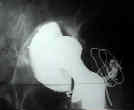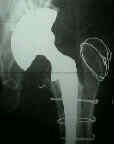- See:
- Total Hip Replacement Menu:
- Acetabular Component Revision
- Femoral Bone Grafting for THR
- Frozen Allograft
- Dysplastic Hip
- Discussion:
- in planning of acetabular reconstruction, major goal is to establish normal anatomic center of rotation;
- key to preventing migration is getting fixation on acetabular periphery;
- block allografts or autografts may be essential to provide proper prosthetic support;
- secure graft fixation with maximum contact of graft to a bleeding host surface is important for appropriate healing and support;
- Paprosky classification:
- descriptive classification of defects:
- cavitary deficiencies
- the anterior and posterior columns and peripheral bone is intact;
- skeleton is intact and therefore these defects are easier to deal with than segmental defect;
- defects should be filled with graft;
- particulate graft is reversed reamed to pack evenly into defects;
- segmental defects:
- segmental defects are repaired w/ structural grafts;
- if sufficient bone is available from iliac crest & shaped to replace absent bone;
- central (medial wall absent)
- pelvic descontinuity
- Operative Strategy:
- component fixation without bone graft:
- if no more than 30-40 % of the surface of the acetabular component remains uncovered, then application of bone graft may not be necessary;
- the graft may be inserted without cement, and an acceptable amount of bone ingrowth may be expected to occur;
- if there is more than 50% uncoverage or pelvic discontinuity, then consider inserting a cemented acetabular cup (or gap cup);
- morselized bone graft:
- references:
- Acetabular revision with impaction bone grafting and a cemented polyethylene acetabular component: comparison of the Kaplan-Meier analysis to the competing risk analysis in 62 revisions with 25 to 30 years follow-up.
- structural bone grafts:
- references:
- Massive acetabular bone loss: Limits of trabecular metal cages
- I Have a Patient With Severe Segmental Bone Loss in the Superior Dome of the Acetabulum. What Should I Do to Reconstruct This Defect?
- Examples:


- example of an acetabular component that was obviously loose after 3 years;
- at surgery, the femoral component was secure and was left in place;
- the acetabulum was re-reamed for insertion of a larger component;
- a cortical allograft was anchored to the lateral femur inorder to re-oppose the abductors
Failure of acetabular autogenous grafts in total hip arthroplasty. Increasing incidence: a follow-up note.
The fate of acetabular allografts after bipolar revision arthroplasty of the hip. A radiographic review.
Fate of bone grafts in acetabular roof reconstructions assessed by roentgenography and scintigraphy.
Femoral head autografting to augment acetabular deficiency in patients requiring total hip replacement. A minimum five-year and an average seven-year follow-up study.
Noncemented acetabular revision arthroplasty using allograft bone.
Acetabular augmentation in primary and revision total hip arthroplasty with cementless prosthesis.
Acetabular Revision Options.
Bipolar components for severe periacetabular bone loss around the failed total hip arthroplasty.
Treatment of type III acetabular deficiencies in revision total hip arthroplasty without structural bone-graft.
Classification and reconstruction in revision acetabular arthroplasty with bone stock deficiency.
Acetabular defect classification and surgical reconstruction in revision arthroplasty. A 6-year follow-up evaluation.
Noncemented acetabular revision arthroplasty using allograft bone.
Principles of bone grafting in revision total hip arthroplasty. Acetabular technique
Total Hip Arthroplasty in Patients with Bone Deficiency of the Acetabulum

